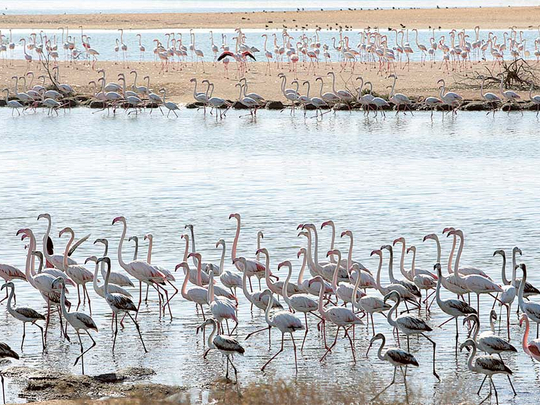
Abu Dhabi: Visitors to Al Wathba Wetland Reserve can catch the magnificent spectacle of hundreds of flamingos feeding in the sanctuary’s shallow water at close quarters thanks to an observation enclosure that merges into the surroundings. The birds range in hue from white and grey to pink.
The observation enclosure is the perfect place to watch the beautiful birds in their natural surroundings without disturbing them. The structure, built by a UK company, has been installed near a favourite retreat of the flamingos, whose numbers have reached around 4,000 in the reserve this winter.
A walk through the well-marked trails to the bird observation area in the wetland reserve spread over five square kilometres leaves visitors wondering how a desert environment could have a natural habitat of hundreds of birds.
The Environment Agency-Abu Dhabi (EAD) manages Al Wathba Wetland Reserve, one of the most important wildlife sanctuaries in the country. The agency plans to install an additional bird hide (camouflaged observation shelter) near the freshwater pools to offer visitors more opportunities for bird watching.
The reserve hosts over 200 migratory birds, 11 mammals, 10 reptiles and over 35 plant species.
Visitors could be lucky to see the metallic-coloured Cuckoo Wasp, known by the scientific name Hedychridium Anithaae, which was recently discovered at the reserve, and was added to the list of hundreds of invertebrates recorded at the reserve. Other species in the reserve include Greater Spotted Eagle, Salvadora, Red fox, Egyptian Spiny-tailed Lizard ‘Dhub’, Desert monitor lizards, Cape desert hares, Purple-blushed darter, Cheesman’s gerbil and Ethiopian hedgehog.
However, flamingos are the most visible denizens of the reserve.
The white and grey flamingos seen close to the observation area are the younger ones in the group and the pink ones are the more mature that are four years old or more, Dr Shaikha Salem Al Daheri, Executive Director, Terrestrial and Marine Biodiversity Sector at EAD, told journalists during a media tour.
Many of these birds have made Al Wathba their residence thanks to the favourable environment, Dr Shaikha said. “They get whatever they want here.”
Many of the birds follow their nomadic instincts and keep on migrating to other places, especially when winter ends in the UAE.
Dr Salim Javed, head of EAD’s bird programme and manager of its biodiversity assessment and monitoring wing, said flamingos keep on moving from one reserve in the UAE to the other throughout the year. “There is a daily movement of birds. That’s why we cannot exactly tell the number of birds in the reserve on a given day. Considering this nomadic nature of flamingos, the UAE has developed a network of reserves across the country to protect them,” he said.
EAD opened the doors of the reserve to the public by appointment only since November after completing the first phase of Al Wathba Wetland eco-reserve project.
“We are providing our community, especially the school and university students, with greater access to these protected areas to enhance their environmental awareness and to connect with nature,” Dr Shaikha said. “This will help them to conduct scientific studies and research, while witnessing how EAD is protecting its rich biodiversity,” she added.












